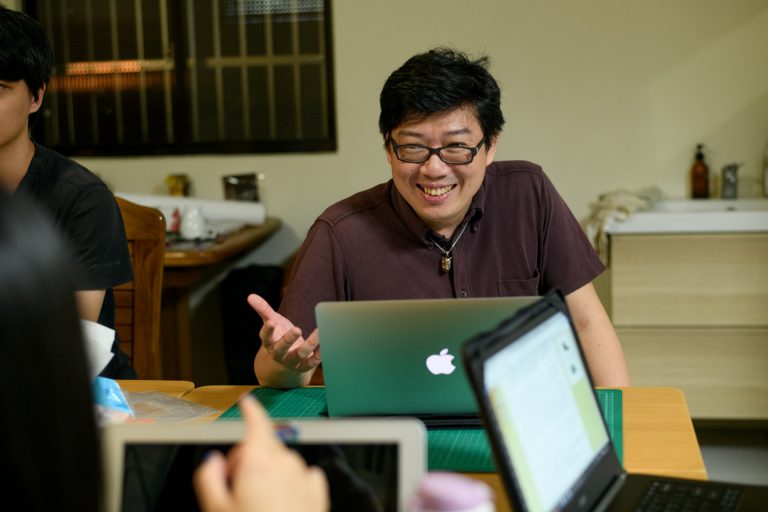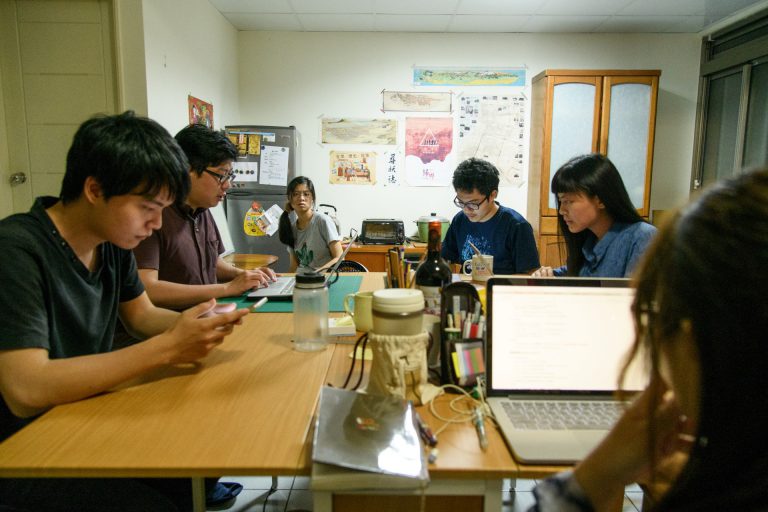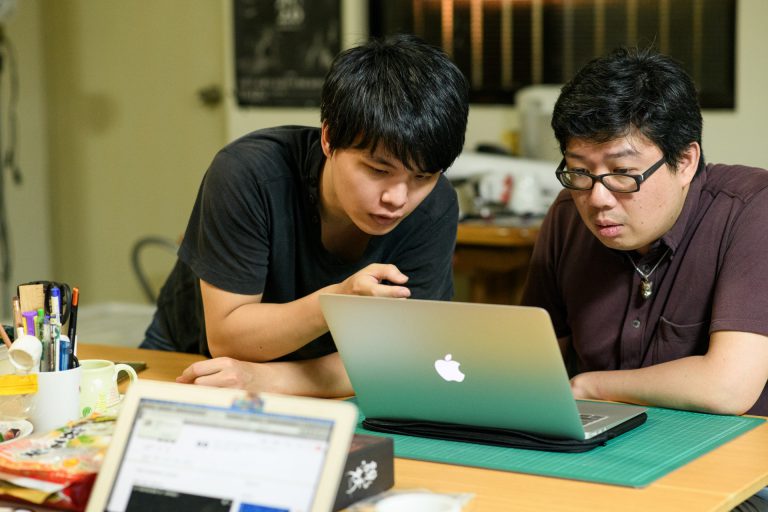有這樣一群人,熱愛遊戲和奇幻文學,同時也關注臺灣的歷史文化、都市地景、傳說與神怪,遂結合興趣與事業,從讀小說到寫小說,再從玩遊戲到設計遊戲。他們是臺北地方異聞工作室(簡稱「北地異」),致力於爬梳文史,將之轉化為故事書寫,試圖以娛樂性的創作,召喚現代人與地方失落記憶的連結。
北地異是由國立臺灣大學、國立政治大學奇幻社的社員於2015年創立的同好團體,團體成員共同投入包含故事創作、獨立出版與遊戲設計,以「城市還魂」為理念,出版原創刊物、設計實境遊戲;以交錯的虛實擾動環境,希望能以文史為城市、社群喚起新的意義。工作室的創作多半以「臺北地方異聞」這個世界觀為主,近年作品如小說《臺北城裡妖魔跋扈》、《帝國大學赤雨騷亂》、臺灣神怪考據故事書寫《唯妖論》、實境遊戲「金魅殺人魔術」、桌遊「說妖」等。
所謂「臺北地方異聞」的世界觀是以日治時代為背景的開放世界觀,大部分的故事發生在1895年(清國割臺)以後,1951年以前。其所處的世界,是相對於讀者所處現實世界的平行世界,雖然與現實世界極其相似,卻也有許多不同。以「臺北」為名,不是因為故事發生在臺北,而是以「臺北結界」這個特殊的殖民裝置為名,事實上,此系列故事遍及全臺。故事的主軸看似殖民者與被殖民者的對立,更重要的卻是呈現多元文化的繽紛瑰麗之美。臺北地方異聞工作室即致力於在真實的地景上,以虛構故事翻轉臺灣民俗和文史的想像。

工作室成員之一,以筆名「瀟湘神」發表奇幻小說的羅傳樵,高中時就開始看奇幻小說,成為奇幻迷,更從奇幻文學將觸角延展到遊戲,也大約是那個時候開始接觸到桌上角色扮演遊戲(Tabletop Role Playing Game,簡稱TRPG),並在大學時代開始經營「瀟湘神的TRPG 觀點」部落格,討論TRPG遊戲的劇情設計,並分析遊戲裡的道德理論和哲學框架。羅傳樵後來進入臺大哲學系修讀碩士班,主修東方哲學,加入時僅十來人的臺大奇幻藝術研究社,更進一步從玩家變成遊戲設計者,也熱衷於研究規則背後的理論系統,影響其日後的創作方向。
TRPG讓羅傳樵有了嶄新的視野。一般而言,電腦上的角色扮演遊戲都有固定劇本,雖然可以在遊戲世界裡自由移動,但玩家大多只能照著設計者的路線走,能觸動的選擇有限,譬如說跟別人對話,內容都是寫好的,玩家只能依循原有設定,並沒有真正的自主性。假如在遊戲中碰到一扇窗,玩家想從窗戶逃跑,但如果設計者沒有設想這樣發展的可能性,就無法這樣做。但是在TRPG的情境裡,每個人寫好自己的角色,直接扮演這個角色,然後再由主持人告知角色身旁的環境,玩家可以在情境中自由採取行動,也可決定要採取什麼態度,或者玩家在遊戲中和別人對話時,可以選擇要用挑釁還是溫和的態度,而不同的選擇會導致不同的結果。所以TRPG最大的魅力即是某種程度上的完全自由,前提是玩家的想像力要夠豐富,才能將自己投入到遊戲情境裡面。
後來北地異設計的實境角色扮演遊戲(Live Action Role Playing,簡稱LARP),則是羅傳樵當時接觸到的另一種遊戲類型。對他而言,兩者最大的差異在於敘事。TRPG可以用華麗的描述去形容,但事件的發生終究不會與現實世界的時間等同;而LARP的一切都是實時進行,玩家彷彿在上演一齣「無劇本的舞台劇」,每個人都實際在扮演角色,帶著各自的敘事線與目的,需要在互動中察言觀色,自行判斷獲得的資訊是否正確。因此,兩者的設計邏輯也完全不同:TRGP的重點是讓玩家適當地進入情境,並且讓情節上的轉折能夠催動情感,遊戲的其他過程就比較趨近於閱讀小說或者看電影;而在LARP的情境中,由於每個人都是自由行動,要避免讓玩家覺得自己的角色不重要或無事可做,就必須仰賴設計時預先設想的各種可能性,排除負面體驗,盡量達到平衡。
 北地異工作室一景。圖 © 空總臺灣當代文化實驗場,王世邦攝影
北地異工作室一景。圖 © 空總臺灣當代文化實驗場,王世邦攝影
2009年時,羅傳樵想建立一個LARP世界觀的遊戲背景,一開始他只有一個粗糙的概念,就是他想設計一個人可以收服妖怪,妖怪也可以控制人的世界觀,在這個遊戲裡,妖怪可以和人戰鬥,也可以和人做朋友。後來他看到日治時期的紀錄片《南進臺灣》,有個畫面是在城中區的十字路口,剛好有一個穿著旗袍的人站在亭仔腳下面,然後也有撐傘穿著和服的人,以及穿著西裝的男子在人力車上,這個視覺衝擊使他大為震撼:「文化這種東西,竟然就在小小的街角同時存在!」
北地異試圖聯繫古今的願景即由此而來,羅傳樵也因此開始對日治時期的歷史背景著迷,《南進臺灣》就像一扇帶領他進入日本時代的門,讓他開始探索那個時代裡有趣的人事物,也開始收集日治時代的史料。回溯臺灣歷史的材料,羅傳樵發現裡頭有太多現在難以想像的東西,也有太多故事可以講述。「人類的想像力太貧乏了,過去其實是非常、非常豐富的,只是需要通過那一扇門而已。」他如此形容。
北地異創作的遊戲風格與比較常見的實戰型LARP大相徑庭,實戰型遊戲裡玩家大多拿著塑膠武器戰鬥,但北地異的遊戲則是比較強調劇本與敘事的劇本型LARP。羅傳樵與夥伴們一開始設計LARP時,因為經驗不足,宛如瞎子摸象般慢慢探索,透過不斷的反覆測試,拿捏遊戲規則的平衡度,才逐漸創作出具有北地異風格的遊戲。這也是北地異的遊戲作品獨創一格的原因,因為那完全是自己摸索出來的東西,不是從別人那裡學來的。
「我想表現出來的風格不只要多元文化,還要往浪漫之美的極限推進。」羅傳樵強調。設計遊戲和寫小說之餘,北地異的作者也需要大量攝取養分,累積美學品味,取材則傾向於現代人不一定熟悉,又可以實際考察的文史資料,並且盡可能展現出最璀璨華麗的一面。後來他們完成了第一個LARP遊戲《帝國大學赤雨騷亂》,也因此讓許多玩家開始對日本時代和過去臺灣的歷史背景產生興趣,有的人因而成為下一場遊戲的主持人,且用這個系統去寫遊戲,故事就此延伸出去,開枝散葉,沒有盡頭。
北地異習慣從文史背景轉化中找尋遊戲的元素,然而文史轉化的重點不只在於搜尋史料、從中發現具有娛樂性的東西,還包括在不破壞原先脈絡的狀態下進行再詮釋。這樣的倫理觀也是北地異強調的準則之一,不能因為材料有趣就輕率使用,對於近代歷史的題材要格外謹慎處理,尤其是日治時代距離現在不算太遙遠,相關人物或其後代可能還存在,文史轉化時就得注意不要讓相關人物感到不受尊重,才不會偏離遊戲原意。
遊戲設計者另一個隱憂則是擔心部分文化元素被意識到以後,若產生快速娛樂化或商品化的現象,會對其本身造成傷害。好比臺灣文化中的魔神仔,如果畫出一個角色形象,但是卻沒有交代牠在傳說中是怎樣的怪物?怎樣作祟?會在哪些地方出沒?這樣魔神仔背後的文化與社會意義就沒傳達出來,那麼發展到最後,就有可能徒留表面,缺乏對其背後意象與文化層面的探究。對此,羅傳樵認為,應該先在臺灣耕耘好足夠厚度的文化想像,才能避免臺灣文化裡的素材被大量的商品去脈絡化。
 北地異目前針對臺灣的妖怪文化進行研究與梳理,並探討其背後的社會意義。圖 © 空總臺灣當代文化實驗場,王世邦攝影
北地異目前針對臺灣的妖怪文化進行研究與梳理,並探討其背後的社會意義。圖 © 空總臺灣當代文化實驗場,王世邦攝影
 北地異創作的遊戲風格強調劇本與敘事,並從文史背景中找尋遊戲的元素。圖 © 空總臺灣當代文化實驗場,王世邦攝影
北地異創作的遊戲風格強調劇本與敘事,並從文史背景中找尋遊戲的元素。圖 © 空總臺灣當代文化實驗場,王世邦攝影
北地異主張的「城市還魂」,就是以城市為背景去設計遊戲,然後讓玩家能夠對這個地方產生情感連結,進而關心背後的歷史。以地景為中心,抽離原來的現實感,加以奇幻和浪漫化,藉此重新體驗到歲月痕跡,這種趣味的「在地化」拉近了人與文化的距離,為歷史回顧注入想像的活水。遊戲當然不是唯一的方式,小說也是,其實任何娛樂創作都可採用這個形式,賦予歷史場景新的意義,至少比單純閱讀生硬的歷史資訊來得有趣。
羅傳樵說,北地異的成員實際透過玩遊戲開始對歷史產生興趣,而講到「城市還魂」,一般人會說那就代表城市已經死了,才有「還魂」這件事。其實城市還魂的說法是來自一般城市裡的建築、古蹟等硬體會被保留下來,但居民不見得能意識到其價值,尤其像臺北市是一個很多外來者遷入的城市,如果居民對於文化環境沒有興趣了解,即使硬體還在,也已經失去意義,此時的記憶就有如死亡一般,而北地異正是透過娛樂和創作,將遊戲作為一種召喚歷史的方式,喚醒它們的價值。
如何進行「召喚」呢?首先,引用大量史料作為故事背景,這在娛樂作品中可以成為一種合理的形式。假如古蹟簡介是透過說明牌讓參觀者閱讀其過往的歷史往往不太吸引人,但如果能把古蹟轉化為遊戲背景,讓參與者能體驗曾經在這個古蹟裡發生的歷史事件,這個場所就會產生新的意義,假如未來這個古蹟消失了,他就會感到惋惜。
奇幻類的創作是強調記憶文化的文類,證據在於人們所引用的神怪大多都是從文化庫裡面抓出來的,傳說中的生物則時常被賦予文化特徵。龍作為一種生物並不具備文化性,但由於東、西方對於龍的想像完全不一樣,當西方的奇幻小說出現一隻東方的龍,就會被指稱為帶有某種異國風情,龍因為被疊加了人類的信仰、道德、風俗等而具備了文化特質。
北地異在研究臺灣的妖怪時,就發現其帶有臺灣文化強烈的混合特質,排灣族傳說中有很多和漢人神話相通的元素,而漢人傳說中的蛇郎君和西方的「美女與野獸」又有異曲同工之處。羅傳樵指出,對於文化的認識越深,就會發現文化不是鐵板一塊,它是流動的,透過妖怪學反而能讓我們對於臺灣文化有更開放的認識,也可回應臺灣因為複雜歷史所產生的文化焦慮,進而以更加開放的態度認識文化裡的多元特質。
目前北地異主要致力的有三個面向,包括持續以文史題材進行小說創作、從文史出發創作遊戲,喚起現代人與過去記憶的連結;同時針對臺灣的妖怪文化進行研究與梳理,進一步探討背後的社會意義;並預計出版相關論述以建立長期討論。在當代城市裡,他們的創作成為記憶文化的另類文脈,不只是開發與傳承,更與參與者激盪出全新的意義和詮釋空間。